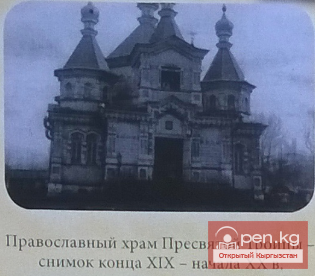
Birthday of Karakol (Przhevalsk) - July 1, 1869
History has preserved for us the exact date, motives, and circumstances of its emergence. It became one of the first settlements established in the Issyk-Kul basin after the voluntary incorporation of Kyrgyzstan into Russia.

In 1865, the tsarist government hurriedly built a series of fortifications on the Kashgar border. One of them, Ak-Su, later became the center of the Karakol district. Ak-Su was located away from trade routes and seasonal migrations of herders, so it was decided to move the district center to a more convenient location. For this purpose, Staff Captain of the General Staff Alexander Vasilyevich Kaulbars was sent to the basin.

“After completing the course at the Academy in 1868, I was assigned to the General Staff of the Turkestan Military District, and in early spring of 1869, I left Petersburg for Tashkent,” he recalled. “At that time, the Governor-General of Turkestan was General-Adjutant Konstantin Petrovich Kaufman, the Chief of Staff of the District was Lieutenant General Dandeville, and his assistant was Major General Petrushevsky. The latter informed me that I was tasked with reconnaissance of the Issyk-Kul Tian Shan with the aim of surveying this mountainous region, which was largely unknown, and to clarify strategic data concerning the Chinese possessions stretching to the south of this area. At that time, these lands were under the control of Badaulet Yakub-bek, who led a rebellion of the local population of Kashgaria, consisting of Tajik and Kara-Kyrgyz tribes, and destroyed Chinese rule with the assistance of the Khan of Kokand.

Upon arriving in the Issyk-Kul valley, I was tasked with:
a) After thorough reconnaissance and gathering all necessary information, to choose a suitable place for relocating the existing city and fortification on the Ak-Su River, whose location was deemed inconvenient for trade with the Tian Shan and beyond, as well as in terms of its geographical position; b) To conduct a detailed survey of the selected area for the new city; c) To outline on the plan and mark on the ground the streets and squares of the future city.

In fulfillment of the assigned task, I arrived on May 16, 1869, in the city of Verny, the residence of the Military Governor Lieutenant General Gerasim Alekseevich Kolpakovsky. After thorough reconnaissance and interviewing local residents, it was decided to lay the new city along the old trade caravan road from the Chuy Valley to Kashgaria, near the ruins of the old Kokand fortress at the mouth of the Karakol River. “On July 1, 1869, the streets, squares, and guesthouse were laid out, and the lower crowns of the defensive barracks were also established,” wrote A.V. Kaulbars later in his “Remarks on the Organization of the City of Karakol.” This date is considered the birthday of the city, which was initially named after the Karakol River.

The construction of Karakol was entrusted to the Issyk-Kul district chief Andrei Petrovich Chaikovsky. The city administration was also involved in the improvement of the city. Builders were instructed to plant fruit and decorative trees simultaneously with the construction of houses. The buildings in the city were mainly made of adobe and mud bricks; however, after the earthquake of 1887, wooden houses began to be built in the city. Trade rows, a public park, barracks, and paved streets complemented the picture of this small oasis nestled at the foot of the Kungey Ala-Too.

In the mid-19th century, a wave of settlers from Russia and Ukraine to the lands of Turkestan brought important features to the cultural and historical characteristics of this region, significantly influencing the further development and formation of local life. Here, the peculiarities of everyday life, farming, and first of all, religious beliefs were closely intertwined. Having settled in the new place, representatives of the Orthodox clergy began to advocate for the establishment of local prayer houses and churches. According to Orthodox traditions, donations began to be collected for the construction of local churches. Metropolitan Vladimir tenderly recounts a case when a man in a large turban and richly embroidered robe entered the home of a peasant who was gathering funds for the construction of a church. Seeing that the peasant was frightened and confused, he calmed him and placed gold coins on the table. This was one of the first donations for the construction of Russian "mosques" made by Muslims of Turkestan.

Thus began the history of the construction of the Holy Trinity Cathedral of the ancient Orthodox church in Karakol. The date of the creation and establishment of the temple goes back to the time of the founding of the city of Karakol by Alexander Vasilyevich Kaulbars, who became the initiator of the erection of a temporary temple made of felt - the material from which practically all buildings of that time were constructed.

In 1887, a strong earthquake destroyed the temple to its foundations. Funds were again allocated from the royal treasury for the construction of a new temple. It was built of wood in less than two years according to a special project by a family of local merchants, the Maslikovs, and was consecrated in 1895.

The church turned out to be very beautiful - with five domes, a bell tower, white walls, and carved blue inlays. There were no other churches nearby, so on holidays, all believers from the surrounding villages gathered in Karakol. The temple was an important educational center - its library contained more than 1,000 books.

The Dungan Mosque, with its architectural uniqueness and painting, is one of the greatest structures of Dungan architecture. The mosque is a magnificent example of Chinese architectural style from the Qing dynasty (1644-1911). It was built in the style of a Buddhist pagoda in 1910 from wood without a single nail or any metal fasteners, thanks to a special system of jointing.








































